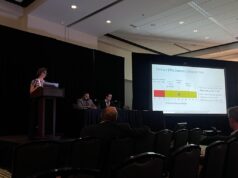
Compared with doxorubicin-loaded drug-eluting embolic transarterial chemoembolization (DEE-TACE), conventional transarterial chemoembolization (cTACE) yielded a higher number of quality-adjusted life years (QALY) at a lower cost, making it the more cost-effective of the two modalities. This is the conclusion reached by a cost-effectiveness analysis published in the Journal of Vascular and Interventional Radiology (JVIR) by Xiao Wu (Yale School of Medicine, New Haven, USA), senior author Nishita Kothary (Stanford University Medical Center, Stanford, USA), and colleagues.
The investigators set out to compare the cost-effectiveness of DEE-TACE versus that of cTACE for patients with unresectable hepatocellular carcinoma (HCC).
They constructed a decision-analysis model that spanned a payer’s entire life; the model simulated the clinical course, including periprocedural complications, additional transarterial chemoembolization or other treatments (ablation, radioembolization, or systemic treatment), palliative care, and death, of patients with unresectable HCC. Describing their methodology, Wu et al explain: “All clinical parameters were derived from the literature. Base case calculations, probabilistic sensitivity analyses, and multiple two-way sensitivity analyses were performed.”
Conventional TACE yielded a health benefit of 2.11 QALYs at a cost of US$125,324, whereas DEE-TACE yielded 1.71 QALYs for US$144,816. In 10,000 Monte Carlo simulations, a mathematical technique used to estimate outcomes of an event, cTACE continued to be a more cost-effective strategy.
The authors report that cTACE was cost-effective when the complication risks for both the procedures were simultaneously varied from 0–30%. DEE-TACE became cost-effective if the cTACE mortality exceeded that of DEE-TACE by 17% in absolute values. The two-way sensitivity analyses demonstrated that cTACE was cost-effective until the risk of disease progression was >0.4% of that for DEE-TACE in absolute values.
“Our analysis showed that DEE-TACE would be more cost-effective if it offered >2.5% higher overall survival benefit than cTACE in absolute values,” Wu and colleagues summarise.
Replying to this journal article as posted on Twitter, Aaron Maxwell (The Warren Alpert Medical School of Brown University, Providence, USA) asked: “If cost effectiveness is being discussed, why not bland embolization alone? No chemotherapy to pay for, and RCT [randomised controlled trial] data with equivalent outcomes to TACE from 2016.”

Responding, study co-author Julius Chapiro (also Yale School of Medicine, New Haven, USA) wrote on Twitter: “Excellent point! While there is some doubt as to the standard of care for the control arm in the JCO paper (DEB-protocol), I am not at all convinced that chemo adds value to beads. Our experimental studies prove the point, too. We must really think about it in depth.”
He posted a figure from a previous JVIR paper authored by the same team, writing: “Even with smaller calibre beads, the drug (heat map) barely covers the entire tumour. Primarily embolic effect. I will say that my journey so far has really made me doubt the value of chemo.
“We now need to understand the immunological effect of the different materials we introduce and how they may or may not affect the tumour microenvironment and immune response (especially + checkpoint inhibitors). I do not see clear striking evidence for DEBs re outcome. None.”
This prompted Maxwell to reply: “Terrific work. I think it is incumbent upon the IR [interventional radiology] research community to aggressively expand our understanding of the tumour microenvironment if we are to optimise outcomes for catheter-directed locoregional liver therapies.”
Chapiro agreed, exclaiming: “We simply have to aggressively expand our science and transform our therapies to be directed to and tailored for the individual tumour microenvironment!”
Speaking directly to Interventional News, Kothary added: “Data on bland embolization are limited, precluding a robust carcinoembryonic antigen (CEA) test. “DEE-TACE is also associated with a higher need for pain control due to its true embolic nature (I would guess that bland embolization is similar), and pain control often requires overnight hospitalisation that would impact a CEA.”










